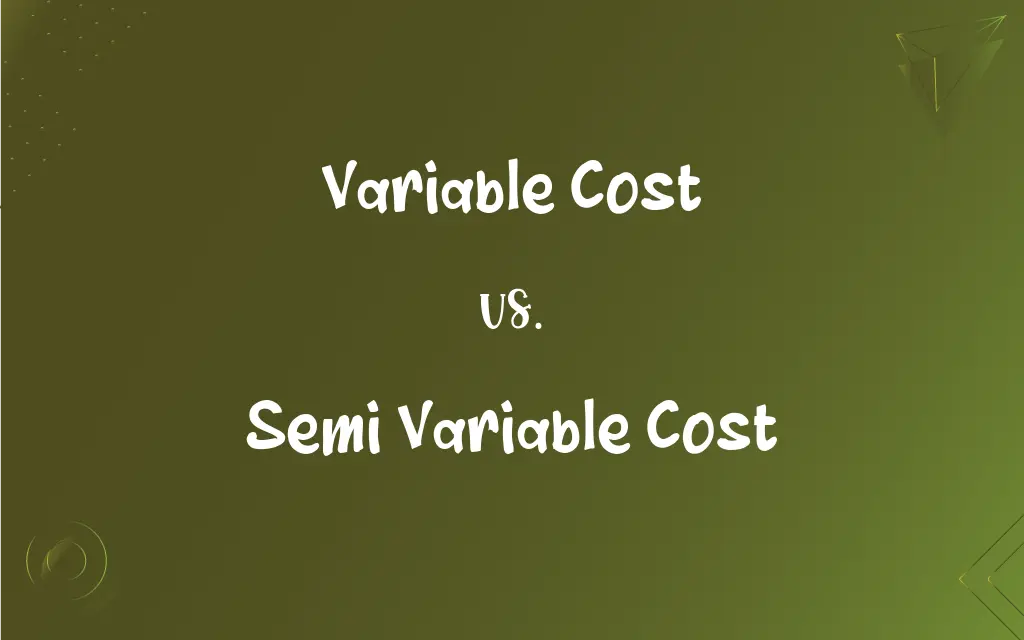Variable Cost vs. Semi Variable Cost: What's the Difference?
Edited by Aimie Carlson || By Harlon Moss || Published on January 1, 2024
Variable costs change directly with production volume, while semi-variable costs have both fixed and variable components, changing partially with production levels.

Key Differences
Variable costs fluctuate entirely in proportion to production output; they increase with more production and decrease with less. Semi-variable costs, however, have a fixed component that remains constant regardless of production levels, and a variable component that changes with production.
Examples of variable costs include raw materials and direct labor, which vary directly with the quantity produced. In contrast, semi-variable costs might include utility bills, where there is a base charge (fixed) plus a variable charge based on usage.
In budgeting, variable costs are straightforward as they align directly with production levels. Semi-variable costs require more complex calculation, considering both the consistent base cost and the variable portion.
When production stops, variable costs can drop to zero, as they are linked directly to production activities. Semi-variable costs will still incur expenses due to their fixed component, even if production is halted.
For financial analysis, understanding variable costs helps in assessing direct production expenses. Semi-variable costs analysis is crucial for understanding overall operational efficiency, as it reflects both fixed obligations and production-related expenses.
ADVERTISEMENT
Comparison Chart
Definition
Costs that change entirely with production
Costs with both fixed and variable components
Examples
Raw materials, direct labor
Utility bills with base plus usage charge
Budgeting Consideration
Align directly with production levels
Require calculation of fixed and variable parts
Behavior When Production Stops
Can drop to zero
Still incur expenses due to fixed component
Relevance in Financial Analysis
Assess direct production expenses
Understand operational efficiency
ADVERTISEMENT
Variable Cost and Semi Variable Cost Definitions
Variable Cost
Expenses that rise or fall in proportion to production activity.
Direct labor in the factory is a variable cost, as it changes with the number of products made.
Semi Variable Cost
Expenses with a constant base cost plus a variable portion.
Maintenance fees for equipment are semi-variable, with a regular fixed fee plus costs based on usage.
Variable Cost
Production costs that fluctuate with output volume.
In the bakery, the cost of flour is a variable cost dependent on the amount of bread baked.
Semi Variable Cost
Overheads that do not vary entirely with production output.
Employee salaries that include a fixed base and overtime payments represent a semi-variable cost.
Variable Cost
Expenses that are directly proportional to production levels.
Utility costs in a manufacturing plant can be a variable cost, increasing with machine usage.
Semi Variable Cost
Expenses that have a stable component and a fluctuating one.
The cost of a cloud service subscription is semi-variable, with a fixed monthly fee plus extra for additional data usage.
Variable Cost
Costs directly linked to the level of production.
The packaging material is a variable cost, increasing with each additional unit packaged.
Semi Variable Cost
Costs partially affected by production levels.
Telecommunication expenses are semi-variable, with a fixed subscription fee plus variable charges.
Variable Cost
Costs that vary directly with production output.
The cost of raw materials is a variable cost that increases with more units produced.
Semi Variable Cost
Costs comprising both fixed and variable components.
The electricity bill is a semi-variable cost, with a fixed monthly charge plus charges for actual usage.
FAQs
Are semi-variable costs common in business?
Yes, they are common in many businesses with both fixed and fluctuating expenses.
What is a variable cost?
A cost that changes in direct proportion to production or sales volume.
Is rent a semi-variable cost?
Generally no, rent is usually a fixed cost unless it includes a variable component.
How are semi-variable costs managed?
By monitoring both the fixed base and the variable usage.
Can a company control its variable costs?
Yes, through efficient production and cost-saving strategies.
What defines a semi-variable cost?
A cost composed of both fixed and variable elements.
Is direct labor a variable cost?
Typically, as it varies with the level of production.
Do variable costs affect break-even analysis?
Yes, they are crucial in calculating the break-even point.
How do variable costs impact pricing?
They affect pricing by changing with production levels, influencing total costs.
Can variable costs become a major expense?
Yes, especially in labor-intensive or material-intensive industries.
Can semi-variable costs be reduced?
Yes, by managing the fixed part and reducing the variable usage.
How do variable costs affect profit margins?
They directly impact margins as they change with production levels.
Why are semi-variable costs important in budgeting?
They affect budgeting due to their complex, dual nature.
How does seasonality affect variable costs?
Seasonal businesses may see significant fluctuations in variable costs.
Can semi-variable costs change with sales volume?
They can, particularly the variable portion related to production or sales activities.
Are utility bills always semi-variable costs?
Often, as they usually have a fixed component plus a usage-based charge.
Is insurance a semi-variable cost?
Usually not, as insurance premiums are typically fixed.
Do variable costs impact financial planning?
Yes, they are a key factor in short-term financial planning.
How do businesses forecast semi-variable costs?
By analyzing past trends and considering fixed and variable components.
Are raw materials a variable cost?
Yes, as their cost varies with the amount used in production.
About Author
Written by
Harlon MossHarlon is a seasoned quality moderator and accomplished content writer for Difference Wiki. An alumnus of the prestigious University of California, he earned his degree in Computer Science. Leveraging his academic background, Harlon brings a meticulous and informed perspective to his work, ensuring content accuracy and excellence.
Edited by
Aimie CarlsonAimie Carlson, holding a master's degree in English literature, is a fervent English language enthusiast. She lends her writing talents to Difference Wiki, a prominent website that specializes in comparisons, offering readers insightful analyses that both captivate and inform.






































































